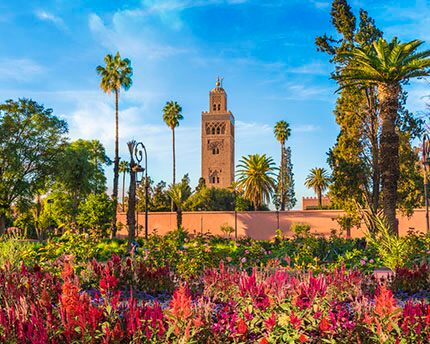The Koutoubia, is a mosque, a building for the worship of the Islamic religion, built in the century XII in the city of Marrakech in Morocco, representative of Almohad art. It is the largest mosque in Marrakech.
The mosque is built with red stone, formerly plastered, and has six rooms in succession, one above the other. It was designed in such a way that anyone was prevented from looking inside from the minaret at the king’s harems.
It is designed in a classic Almohad style and the towers are adorned with copper globes.
It is situated in the southwest of the Medina of Marrakech and southwest of the Jamaa el Fna square next to the Mohamed V avenue.
The mosque is adorned with curved windows, a band of ceramic inlaid, pointed merlons and decorative arches; It has a large square with gardens, and it is illuminated with spotlights at night.
The Koutubía stands out for its 66-meter high minaret (according to other sources, 77 meters), which is the tallest building in the city.
Includes a needle and orbs. The minaret is the symbol and landmark of the city and, without a doubt, its most representative monument.
It was completed in the reign of the Berber Almohad caliph Yaqub al-Mansur (from 1184 to 1199) and served as a model for the construction of the Giralda in Sevilla (Spain) first, and the unfinished Hasan Tower in Rabat (Morocco) later.
The mosque is located about 200 meters west of the souk on Jemaa el Fna square, a prominent market square that has existed since the creation of the city.
To the west and south of the mosque is a prominent rose garden, and across the avenue Houmman-el-Fetouaki is the small mausoleum of Yusuf ibn Tashfin, the builder of Marrakech, a simple crenellated structure.
The minaret is a symbol of Marrakech. All the names and spelling of the Koutoubia mosque, including Jami ‘al-Kutubiyah, Kotoubia, Kutubiya, and Kutubiyyin, are based on the Arabic word koutoubiyyin, which means «bookseller.»


Leave A Comment